AKARA-ISE, a joint venture between Thailand’s Akara Group and ISE Foods Japan, plans to launch a premium brand of eggs that are so fresh and hygienic that they can be eaten raw.
The company has invested over 300 million baht in new 12 layer houses accommodating 600,000 birds. Akara Group holds a majority of the shares. Registered capital was not disclosed.
Akara-Ise will focus on the modern trade segment where quality and freshness are the keys to differentiating Akara Group from its competitors.
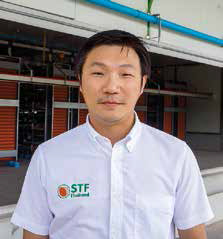
Thanawut Ualapan
“Egg quality will be on par with Japan’s best-selling ISE eggs,” said Thanawut Ualapan, vice chairman Akara-Ise, adding that ISE Foods Group sells around 12 million eggs/day in Japan and 12 million eggs/day in the US.
The product, set to appear on Thai supermarket shelves in Q4, will boast ISE’s uncompromising quality control system combined with Akara Group’s managerial and marketing skills, Mr Thanawut added.
The first shipments of “entry-level” eggs will match the quality of those produced in Japan in terms hygiene and physical characteristics. The only difference is that Akara-Ise’s eggs will be handled at ambient temperature after leaving the packing facility. The eggs are guaranteed free of pathogenic bacteria and can be eaten raw.
It will also offer Mori-Tama, a brand of ultra-fresh and hygienic eggs which can also be served raw. The Mori-Tama eggs are pitched as being a step ahead of competing brands due to superior freshness and overall quality. With a haugh unit above 70%, the super-premium eggs will be handled within a cold chain from farm to retail shelf and will be marketed to Japanese restaurants and consumers who prefer Japanese-style freshness and hygiene.
Mori-Tama and ISE-Tama’s target markets are customers who are willing to pay extra for superior freshness and overall quality.
Plans are in the works for a third brand featuring top-of-the-line “ISE-Tama” quality eggs produced by hens supplemented with special nutrients. The company’s marketing team is currently working on product designs.
Capturing a share of the elite egg market requires special effort, but it is very attractive for producers because it is less subject to price volatility and market sentiment, he added.
Both Mori-Tama and ISE-Tama aim to craft a specialized market niche serving customers who value freshness and overall quality. Output of the first phase will be reserved for the local market, said Mr Thanawut.
Potential export markets are Hong Kong and Singapore. The exported eggs will be shipped via air-conditioned containers capable of maintaining freshness for up to 30 days. So far, small volumes have already been shipped to premium outlets in Cambodia.
Akara Group is ready to export to Singapore. It has already been audited and approved by Singapore’s Agri-Food & Veterinary Authority.
Production
The company is currently using Lohmann Brown-Classic. The pullets are transferred from nearby farms at 16 weeks of age.
He expects flock performance to be on par or above current Akara Group standards.
First laying starts at 18 weeks. Peak production, the point where the birds yield 90% of total production, starts at week 23. The birds retain peak yield above 90% until week 52. Livability during the laying period averages 90-92%, FCR 2.15-2.2, and feed consumption during production is less than 125 grams/day.
Eggs per hen housed at 72 weeks of age is above 311 pieces.
Culling age is greater than 72 weeks, depending on production and egg prices.
A lighting program is in effect from week 16 until end of production. The birds are exposed to light for 14 hours/day at an intensity of 10-15 lux.
Vaccination program includes Marek, Newcastle, Gumboro, infectious bronchitis, and mycoplasma. The birds are fed a vegetarian diet to eliminate fishy taint and reduce the risk of salmonella contamination. Salmonella vaccine is not used.
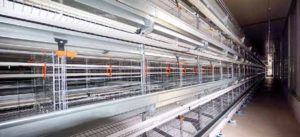
Big Dutchman UV 600 battery cages, 60 cm wide by 60 cm deep. Each house is fitted with
five rows of four-tier cages stocking 50,000 birds in total.
Twelve houses (15x105x3.5m) hold 600,000 birds in total. Each house is fitted with five rows of battery cages stacked four tiers high for a total height of 286 cm. The Univent UV600 series, commonly used in Japan, is 5-8 cm higher than typical battery cages available in the local market.
The extra height gives enough room to prevent the birds from pecking leftover feces off the manure belt. This reduces the risk of salmonella contamination and pathogenic bacteria exposure.
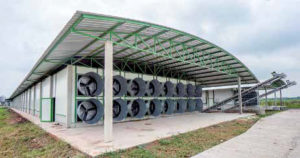
Each house (15x105x3.5m) is fitted with 16 1.5-hp fans 127 cm in diameter for maximum air
movement capacity of 36 m/sec.
Ventilation control, feeding, water and lighting systems are automatically controlled using a “Viper 1520” touch screen controller that is reliable and simple to operate.
The controller can automatically turn fans on and off and track water and feed consumption. Feeding time, amount of feed and feeding frequencies are all programmable.
The system keeps track of the amount of feed consumed and promptly notifies the operations manager if water and feed consumption deviates from the plan.
The controller monitors the water pressure of each individual pipe and triggers an alarm for
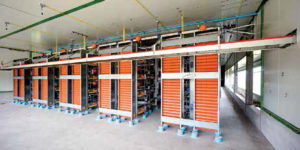
Eggs are gently conveyed from cages via belt to elevator and then to a crossbelt with a
capacity of 45,000 eggs/hour to a collection room attached to the layer house.
each particular house should water pressure drop or water consumption dip below the daily requirement. There is also a back up ventilation system.
In the worst-case scenario, such as a main controller breakdown, the backup system AC3T controller will take over ventilation and assure a continuous flow of fresh air to thwart losses from suffocation.
The Viper touch screen constantly provides updates on feed and water consumption, temperature and air movement in the house, enabling a single stockman to oversee 300,000 birds.
Each house has an egg storage room where a worker puts eggs on trays and transfers them to
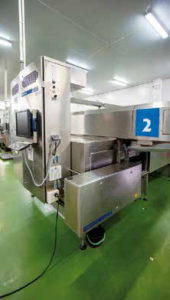
Egg grader with blood spot detector means
that blood spot-free eggs are guaranteed.
a grading facility. The separate egg rooms offer an extra layer of biosecurity for preventing disease from spreading between houses.
The birds are automatically fed via feed hoppers. Daily intake is 110-115 grams/ day, and water consumption averages 220-230 ml/bird/day.
Feed formulation is based on recommended nutrient levels provided by the breed supplier: protein 15-16%, lysine 0.59-0.61% and methionine 0.35-0.37%.
Each cell contains eight birds, with space per bird over 450 sq cm. Feeding space is 10 cm/bird with two nipple drinkers.
The farm is ISO 22000 certified and the eggs are fully traceable.
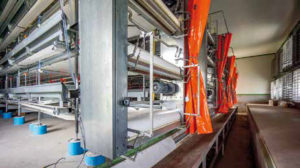
Big Dutchman UV 600 battery cages, 60 cm wide by 60 cm deep. Each house is fitted with
five rows of four-tier cages stocking 50,000 birds in total.
Some nine tonnes of fresh manure is removed from the houses every day via manure belts underneath the cages.
Cleaning procedures, cleanliness and overall egg quality are on par with ISE’s operations in Japan. That includes concentration of chlorine in the shell washing water, cleaning and drying procedures, and regular eggshell swabs for salmonella detection, said Mr Thanawut.
Even so, there are still areas that need to be fine tuned, for example, nutrition, feeding and vaccination programs best suited for Thailand’s hot and humid climate.
Thailand will serve as a hub serving ISE alliances in South and Southeast Asia which are currently operating in Mr Thanawut said that the company will procure feed from outside suppliers instead of starting up its own feed mill.
Feed samples are regularly sent for lab testing at Kasetsart University. The eggs are tested for heavy metals, insecticides, Indonesia and Vietnam.
and avian influenza at least once a year in line with the requirements of Thailand’s National Bureau of Agricultural Commodity and Food Standards.
Marketing
Akara-Tama’s priority is to strengthen its brand presence in all market segments. It targets capturing 5-10% of the total output in the premium segment and 20-30% in the modern trade segment, especially at Japanese supermarket chains such as MaxValu, UFM Fuji Super, Top Supermarket, Gourmet Market and Villa supermarket by the end of 2016. It projects market share growth in the premium segment to reach 20% in 2017.
MaxValu operates more than 30 stores across the country. Over 70% of MaxValue and UFM Fuji Super’s clientele are Japanese expatriates.
The branding concept aims to attract Japanese food lovers. The quality of Akara-Tama fresh eggs will be comparable to those of local market leaders and offer great value, he said.
Eggs of the flagship Mori-Tama and ISETama brands will weigh 65-75 grams/ apiece and won’t conform to the conventional category system in the market.
In 2017, it is looking to co-brand with Japanese restaurants and new clients in the hotel, restaurant and food service segments.
Egg packing facility upgrade
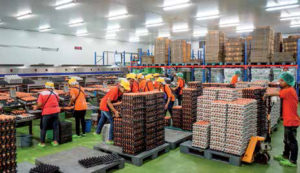
Air-conditioned egg grading facility, temperature 25°C. Construction of a cold storage room
capable of holding 4,000,000 eggs is underway.
The company plans to triple its grading and packing capacity with a new egg grading and washing system installation to be completed in the first half of 2017.
Once finished, its grading capacity will surpass two million pieces/day. The fully automated equipment means that no additional workers will need to be hired, he said.
The grading machines will be capable of detecting off-spec shell colour, cracks and blood spots.
At present, haugh unit and yolk colour testing is conducted daily, with 3% of fresh eggs undergoing the test. Average yolk colour is between 10-14 of 15 on the DSM colour fan. Lighter yolk colour, at number 8-9 on the colour fan, is offered for some customers.
Besides table eggs, Akara Group operates one of Thailand’s largest layer parent stock farms, churning out 200,000 layer chicks/week.
